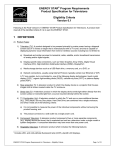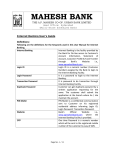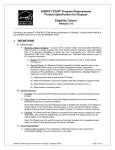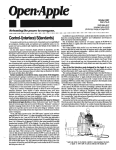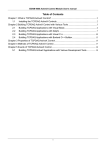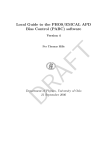Download ENERGY STAR Version 5.3 Televisions Specification
Transcript
ENERGY STAR® Program Requirements Product Specification for Televisions Eligibility Criteria Version 5.3 Following is the Version 5.3 ENERGY STAR Product Specification for Televisions. A product shall meet all of the identified criteria if it is to earn the ENERGY STAR. 1 DEFINITIONS A) Product Types: 1) Television (TV): A commercially available electronic product designed primarily for the reception and display of audiovisual signals received from terrestrial, cable, satellite, Internet Protocol TV (IPTV), or other digital or analog sources. A TV consists of a tuner/receiver and a display encased in a single enclosure. Cathode-ray tube (CRT), liquid crystal display (LCD), and plasma display panel (PDP) are examples of common display technologies. 2) Rear-projection TV: A television product in which the display device is a projector that focuses images onto a screen located inside the TV enclosure. 3) Direct-view TV: A television product in which the display device emits light either directly from the screen surface or transmits light from a source mounted directly behind the screen. 4) TV Combination Unit: A television product in which the TV and one or more additional devices (e.g., DVD player, Blu-ray Disc player, Hard Disk Drive) are combined into a single enclosure, and which meets all of the following criteria: a) it is not possible to measure the power of the individual components without removing the product housing; and b) the product connects to a wall outlet via a single power cord. 5) Component Television: A television product composed of two or more separate components (e.g., display device and tuner) that is marketed and sold as a television under a single model or system designation. A component television may have more than one power cord. 6) Hospitality Television: A television product which includes the following features: a) a control port for bi-directional communication (DB-9, RJ11, RJ12, RJ45, coaxial cable, or HDMI-CEC); b) activated hospitality protocol software (e.g., SmartPort, MPI, MTI, Serial Protocol) to provide direct access to Video-On-Demand (VOD) systems or a digital media player designed for hospitality-specific applications; and c) a power state that meets the definition of Download Acquisition Mode. 7) Analog Television: A television product which has an NTSC, PAL, or SECAM tuner, and may have analog video inputs (e.g., composite video, component video, S-video, RGB). ENERGY STAR Program Requirements for Televisions – Eligibility Criteria Page 1 of 9 8) Digital Television: A television product which has at least one digital tuner or at least one digital video input (e.g., HDMI). Products with an analog tuner and both analog and digital inputs are considered digital products under this specification. B) Native Vertical Resolution: The physical pixel count for the vertical axis of the television (e.g., a television with a screen resolution of 1920 x 1080 (horizontal x vertical) would have a native vertical resolution of 1080). C) Electronic Program Guide (EPG): An interactive on-screen menu of TV program information downloaded from an external source (e.g., program time, date, descriptions). D) External Power Supply (EPS): Also referred to as External Power Adapter. A component contained in a separate physical enclosure external to the television casing, designed to convert line voltage ac input from the mains to lower dc voltage(s) in order to provide power to the television. An EPS connects to the television via a removable or hard-wired male/female electrical connection, cable, cord or other wiring. E) Point of Deployment (POD) Module: A conditional access module for digital cable signal reception. F) Luminance: The photometric measure of the luminous intensity per unit area of light traveling in a given direction, expressed in units of candelas per square meter (cd/m^2). G) Operational Modes: 1) On Mode: The power mode in which the product is connected to a mains power source, has been activated, and is providing one or more of its principal functions. The common terms “active”, “inuse” and “normal operation” also describe this mode. a) Power Overhang State: A limited-duration power state within On Mode that is intended to facilitate a product’s rapid return to full On Mode functionality or provide time for the product to perform functions required for safe shutdown (e.g. operation of cooling fans) after being switched into a low power state by the user. 2) Sleep Mode: The power mode, sometimes referred to as “Standby,” in which the product is connected to a mains power source, is not providing a principal function, and offers one or more of the following user oriented or protective functions, which may persist for an indefinite time: a) to facilitate the activation of other modes (including activation or deactivation of On Mode) by remote switch (including remote control), internal sensor, timer. b) continuous function: information or status displays including clocks. c) continuous function: sensor-based functions. Sleep Mode is defined as the time when the product is connected to a power source, produces neither sound nor picture, neither transmits nor receives program information and/or data (excluding data transmitted to change the unit’s condition from Sleep Mode to On Mode), and is waiting to be switched to On Mode by a direct or indirect signal from the consumer (e.g., with the remote control). 3) Off Mode: The power mode in which the product is connected to a mains power source, is not providing any On Mode or Sleep Mode functions, and where the mode may persist for an indefinite time. An indicator that only shows the user that the product is in the off position is included within the classification of an Off Mode. ENERGY STAR Program Requirements for Televisions – Eligibility Criteria Page 2 of 9 4) Download Acquisition Mode (DAM): The power mode in which the product is connected to a mains power source, produces neither sound nor picture, and is actively downloading data. Data downloads may include channel listing information for use by an electronic programming guide, TV setup data, channel map updates, firmware updates, monitoring for emergency messaging / communications or other network communications. H) Screen Area: The viewable screen area of the product, calculated by multiplying the viewable image width by the viewable image height. I) Product Family: A group of product models that are (1) made by the same manufacturer, (2) subject to the same ENERGY STAR qualification criteria, and (3) of a common basic design. Product models within a family differ from each other according to one or more characteristics or features that either (1) have no impact on product performance with regard to ENERGY STAR qualification criteria, or (2) are specified herein as acceptable variations within a product family. For Televisions, acceptable variations within a product family include: 1) Color, and 2) Housing. 2 SCOPE 2.1 2.1.1 Included Products Products that are (1) marketed to the consumer as a television (e.g., television is the primary function), (2) capable of being powered from either a wall outlet or a battery unit that is sold with an external power supply, and (3) meet one of the following product type definitions, are eligible for ENERGY STAR qualification, with the exception of products listed in Section 2.2: i. ii. iii. iv. v. 2.2 Televisions Television Combination Units Component Televisions Hospitality Televisions Products with a computer input port (e.g., VGA) that are marketed and sold primarily as televisions. Excluded Products 2.2.1 Products that are covered under other ENERGY STAR product specifications are not eligible for qualification under this specification. The list of specifications currently in effect can be found at www.energystar.gov/products. 2.2.2 Products that satisfy one or more of the following conditions are not eligible for ENERGY STAR qualification under this specification: i. Products with a computer input port (e.g., VGA) that are marketed and sold primarily as computer monitors, ii. Products that are marketed and sold as dual-function televisions / computer monitors, and iii. Products that do not have a power state meeting the definition of Sleep Mode (e.g., Public Alert CEA2009A certified models which offer 24/7/365 active public alert features), with the exception of Hospitality Televisions that meet the requirements specified in Section 3.7. ENERGY STAR Program Requirements for Televisions – Eligibility Criteria Page 3 of 9 3 QUALIFICATION CRITERIA 3.1 Significant Digits and Rounding 3.1.1 All calculations shall be carried out with actual measured or observed values. Only the final result of a calculation shall be rounded. Calculated results shall be rounded to the nearest significant digit as expressed in the corresponding specification limit. 3.1.2 Unless otherwise specified, compliance with specification limits shall be evaluated using exact values without any benefit from further rounding. 3.2 3.2.1 General Requirements External Power Supply (EPS): If the product is shipped with an EPS, the EPS shall meet the level V performance requirements under the International Efficiency Marking Protocol and include the level V marking. Additional information on the Marking Protocol is available at www.energystar.gov/powersupplies. • 3.2.2 External Power Supplies shall meet level V requirements when tested using the Test Method for Calculating the Energy Efficiency of Single-Voltage External Ac-Dc and Ac-Ac Power Supplies, Aug. 11, 2004. User Information: The product shall ship with consumer informational materials located in either (1) the hard copy or electronic user manual, or (2) a package or box insert. These materials shall include: i. ii. Information about the ENERGY STAR program, Information on the energy consumption implications of changes to default as-shipped television configuration and settings, and iii. Notification that enabling certain optional features and functionalities (e.g., instant-on), may increase energy consumption beyond the limits required for ENERGY STAR qualification, as applicable. 3.2.3 Forced Menu: Any product that includes a forced menu upon initial start-up shall: i. ii. 3.2.4 Provide users with a choice of “home” picture mode or “retail” picture mode. Partners may use alternative terminology if approved by EPA. Upon selection of “retail” picture mode at initial start-up, either (1) display a second prompt requiring the user to confirm the choice of “retail” picture mode, or (2) display information on the start-up menu that the “home” picture mode is the mode in which the product qualifies for ENERGY STAR. If option (2) is selected, additional detail about ENERGY STAR qualification and energy consumption expectations shall be included in printed product literature and on the product information page on the Partner’s website. Component Televisions: For component television products, the total power of all components shall be considered for evaluation against any power requirement in this specification. ENERGY STAR Program Requirements for Televisions – Eligibility Criteria Page 4 of 9 3.3 3.3.1 On Mode Requirements For products with Automatic Brightness Control (ABC) enabled by default, On Mode power (PON), as calculated per Equation 1, shall be less than or equal to the Maximum On Mode Power Requirement (PON_MAX), as calculated per Table 1. Equation 1: Calculation of On Mode Power for Products with ABC Enabled by Default PON = (0.55 × P0 _ BROADCAST ) + (0.45 × PABC _ BROADCAST ) Where: PON is the calculated On Mode power, P0_BROADCAST is the measured On Mode power when tested with a minimum ambient light level of 300 lux, PABC_BROADCAST is the measured On Mode power when tested with an ambient light level of 0 lux. 3.3.2 For products that do not offer ABC, or for which ABC is not enabled by default, On Mode power (PON), as calculated per the ENERGY STAR test method shall be less than or equal to the Maximum On Mode Power Requirement (PON_MAX), as calculated per Table 1. Table 1: Calculation of Maximum On Mode Power Viewable Screen Area, A (square inches) 3.3.3 3.4 PON_MAX (watts) A < 275.0 (0.130 × A) + 5.0 275.0 ≤ A ≤ 1068.0 (0.084 × A) + 18.0 A > 1068.0 108.0 Measured Power Overhang state power shall be less than or equal to the Maximum On Mode Power Requirement (PON_MAX), as calculated per Table 1. Sleep Mode Requirements 3.4.1 Measured Sleep Mode power (PSLEEP) shall be less than or equal to 1.0 W. 3.4.2 If a product offers multiple Sleep Modes, the Sleep Mode with the lowest power consumption shall be enabled by default. 3.5 3.5.1 Luminance Requirements Measured peak luminance in the “home” (or default, as-shipped) picture mode (LHOME) shall be greater than or equal to 65% of measured peak luminance in the “retail” (or brightest-selectable) preset picture mode (LRETAIL). ENERGY STAR Program Requirements for Televisions – Eligibility Criteria Page 5 of 9 3.6 3.6.1 Download Acquisition Mode (DAM) Requirements A product may automatically exit Sleep Mode and enter Download Acquisition Mode according to a predefined schedule, in order to: i. Download channel listing information for use by an electronic programming guide, ii. Monitor for emergency messaging/communications, or iii. Communicate via a network protocol. 3.6.2 3.7 Measured DAM energy consumption for all DAM states (EDAM) shall be less than or equal to 40 watt-hours per day (0.04 kWh/day). Hospitality Television Requirements 3.7.1 Hospitality Television TEC (TECHOSP), as calculated per Equation 3, shall be less than or equal to the Maximum Hospitality Television TEC Requirement (TECHOSP_MAX), as determined per Table 2. 3.7.2 For Hospitality Televisions that feature an always-on DAM, measured DAM power (PDAM) shall be less than or equal to 1.0 W when tested per the Sleep Mode test procedures in the ENERGY STAR Test Method for Televisions. Equation 2: Calculation of TEC for Hospitality Televisions (TECHOSP) TEC HOSP = (PON × 5) + (PSLEEP × 19) + E DAM Where: TECHOSP is the calculated Hospitality Television TEC PON is the measured On Mode power PSLEEP is the measured Sleep Mode power EDAM is the measured DAM energy over a 24 hour period Table 2: Calculation of Maximum TEC Requirement for Hospitality Televisions (TECHOSP_MAX) Screen Area, A (square inches) TECHOSP_MAX (watt-hours) A < 275.0 (0.65 × A) + 84.0 275.0 ≤ A ≤ 1068.0 (0.42 × A) + 184.0 A > 1068.0 599.0 ENERGY STAR Program Requirements for Televisions – Eligibility Criteria Page 6 of 9 4 TESTING 4.1 4.1.1 Test Methods When testing Television products, the test methods identified in Table 3 shall be used to determine ENERGY STAR qualification. Table 3: Test Methods for ENERGY STAR Qualification Operational Mode All Test Method ENERGY STAR Test Method for Televisions, Rev. Aug-2010 IEC 62087, Ed 2.0: Methods of Measurement for the Power Consumption of Audio, Video and Related Equipment On Mode CEA-2037: Determination of Television Average Power Consumption (December 2009) Sleep Mode Download Acquisition Mode 4.2 4.2.1 4.3 4.3.1 IEC 62301, Ed 1.0: Household Electrical Appliances – Measurement of Standby Power. CEA: Procedure for DAM Testing Number of Units Required for Testing Representative Models shall be selected for testing per the following requirements: i. For qualification of an individual product model, a product configuration equivalent to that which is intended to be marketed and labeled as ENERGY STAR is considered the Representative Model; ii. For qualification of a product family, any product configuration within the family may be considered the Representative Model. International Market Qualification Products shall be tested for qualification at the relevant input voltage/frequency combination for each market in which they will be sold and promoted as ENERGY STAR. 5 DATA AVAILABILITY 5.1.1 EPA will make On Mode, Sleep Mode, luminance, and DAM data available on the ENERGY STAR Web site for interested consumers. On Mode power and luminance data in both home and retail modes will be published on the ENERGY STAR website. 5.1.2 EPA will publish an estimate of annual energy consumption (in kWh/year) on the ENERGY STAR qualified product list. This estimate will be based on typical energy consumption (TEC) model that assumes a daily duty cycle of 5 hours in On Mode and 19 hours in Sleep Mode, plus estimated annual energy consumption in Download Acquisition Mode. ENERGY STAR Program Requirements for Televisions – Eligibility Criteria Page 7 of 9 6 USER INTERFACE 6.1.1 Partners are encouraged to design products in accordance with the user interface standard IEEE P1621: Standard for User Interface Elements in Power Control of Electronic Devices Employed in Office/Consumer Environments. For details, see http://eetd.LBL.gov/Controls. 7 EFFECTIVE DATE 7.1.1 Effective Date: The Version 5.3 ENERGY STAR Televisions specification shall take effect on the date specified in Table 4. To qualify for ENERGY STAR, a product model shall meet the ENERGY STAR specification in effect on its date of manufacture. The date of manufacture is specific to each unit and is the date (e.g., month and year) on which a unit is considered to be completely assembled. Table 4: Specification Effective Dates Effective Date September 30, 2011 7.1.2 Future Specification Revisions: EPA reserves the right to change this specification should technological and/or market changes affect its usefulness to consumers, industry, or the environment. In keeping with current policy, revisions to the specification are arrived at through stakeholder discussions. In the event of a specification revision, please note that the ENERGY STAR qualification is not automatically granted for the life of a product model ENERGY STAR Program Requirements for Televisions – Eligibility Criteria Page 8 of 9 APPENDIX A: Sample Calculations Viewable Diagonal Screen Size (inches) Aspect Ratio Viewable Screen Size, w x l (Inches) Screen Area, A (sq-inches) PON_MAX (watts) 20 16:9 17.4 x 9.8 170.5 27.0 32 16:9 27.9 x 15.7 438.0 55.0 42 16:9 36.6 x 20.6 754.0 81.0 50 16:9 43.6 x 24.5 1068.2 108.0 60 16:9 52.3 x 29.4 1537.6 108.0 ENERGY STAR Program Requirements for Televisions – Eligibility Criteria Page 9 of 9









